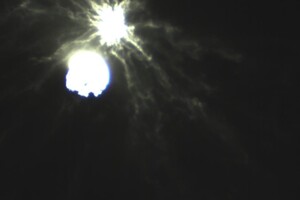In the images, you can see the dust particles released as a result of the collision.

Light Italian CubeSat for Imaging of Asteroids (LICIAcube) took pictures of the collision of the Double Asteroid Redirection Test (DART) apparatus with the satellite of asteroid Didim, Dimorph, reports Science alert. The collision was the first attempt in human history to interfere with the movement of celestial bodies in the Solar System.
The collision occurred at a distance of 11 million kilometers from Earth. NASA broadcast the event from a camera mounted on DART. However, it did not give an idea of how the collision would look to an outside observer.
Read also: Dinosaurs were on the way to extinction even before the fall of the asteroid – scientists
In order to obtain such images, the LICIAcube, equipped with two optical cameras, was used. Cubsat deployed shortly before the collision and was able to capture images of this event.
In the images received, you can see a large, bright object – asteroid Didim. In addition, several thin “threads” are visible – this is the dust that was released as a result of the impact on the Dimorph.
The resulting images should help scientists understand what part of the celestial body was disturbed by the impact, as well as develop future missions to change the motion of asteroids.
Here are the first images of the #LICIACube of #DARTmission impact on asteroid #Dimorphos.
New ages and hours of hardwork are now beginning for schoolchildren and technicians who are implemented in this mission, if you will visit that will have many! pic.twitter.com/kVz1WmcsL7— LICIACube (@LICIACube) September 27, 2022
Recall that the launch of the DART mission took place on November 24, it was carried out using a rocket- carrier Falcon 9. On the night of September 27, it crashed into Dimorph at a speed of about 23,760 kilometers per hour. It is expected that the collision should change the trajectory of the satellite around the parent body.
Related video
The binary system was discovered back in 1996. It consists of two celestial bodies: Didyma with a diameter of about 780 meters and Dimorph, whose diameter is estimated at 160 meters.




